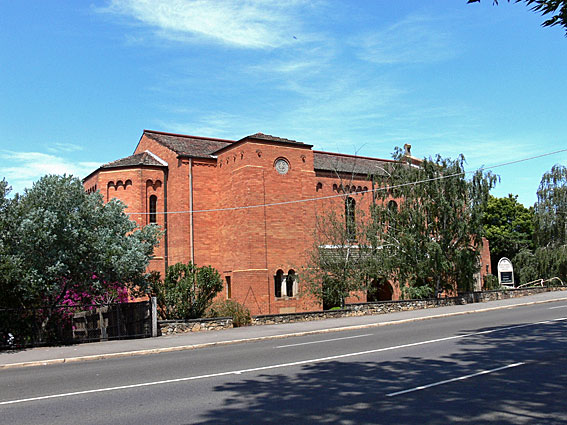
Frank Paton Memorial Presbyterian Church, Deepdene: building from the north-west
showing the organ chamber [photograph by John Maidment (c.2010)]
Historical and Technical Documentation by John Maidment
© OHTA, 2020 (last updated October 2020)

Frank Paton Memorial Presbyterian Church, Deepdene: building from the north-west
showing the organ chamber [photograph by John Maidment (c.2010)]
Historical and Technical Documentation by John Maidment
© OHTA, 2020 (last updated October 2020)
The Frank Paton Memorial Presbyterian Church was built to commemorate the ministry of Frank Paton who had been appointed to Deepdene Presbyterian Church in 1925. Paton was Moderator of the Presbyterian Church in Victoria and served as the church's Foreign Mission Secretary from 1907 to 1935. He retired as minister at Deepdene in 1936 and died in 1938.
Building of a new church began in 1941, a rare example of a church constructed during the initial years of World War 2. The architects Scarborough, Robertson & Love were previously known for the design of the outstanding Littlejohn Memorial Chapel at Scotch College, Hawthorn.
Work has been begun on the erection of the new Frank Paton Memorial Presbyterian at Deepdene. The building is being erected in front of the present church in Burke rd., just north of Cotham rd.
The church generally is of brick construction, with Hawkesbury freestone dressings. The architectural character is derived from early medieval Romanesque, which style was selected as being the most suitable for the unusual site. The land slopes back from the roadway, and if the orthodox Gothic style had been used the roof would have appeared too prominently.
A covered way along one side of the church connects the main entrance with the north porch giving inter-communication which assists the working arrangements of the building.
Provision has been made for a future pipe-organ. The vestry section includes accommodation for the minister and choir, storeroom, and music-room. Seating is provided for a congregation of 350 and a choir of 30.
Scarborough, Robertson, and Love, 368 Collins st, are the architects, and Mr. A.A. Meyer the builder.1
The building was dedicated on Saturday 29 November 1941.2
FIRST ORGAN
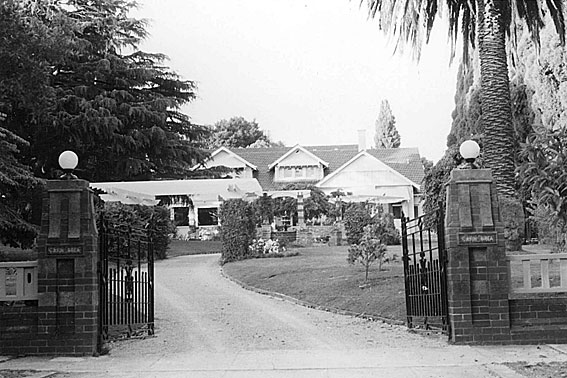
'Carn Brae', Hawthorn
[photograph by John T. Collins / State Library of Victoria (6 January 1983)]
This was built in 1928 by the Aeolian Company, New York (opus 1692) for 'Carn Brae', the residence of Alfred Nicholas, in Harcourt Street, Hawthorn where it was placed in a spacious two-storey ballroom to the rear of the house. The initial contract was for US$16,500, to which was added a four-rank Echo Organ for US$4,400.00; a further three ranks were added in a contract dated 30 July 1929 at a cost of US$2,575.3
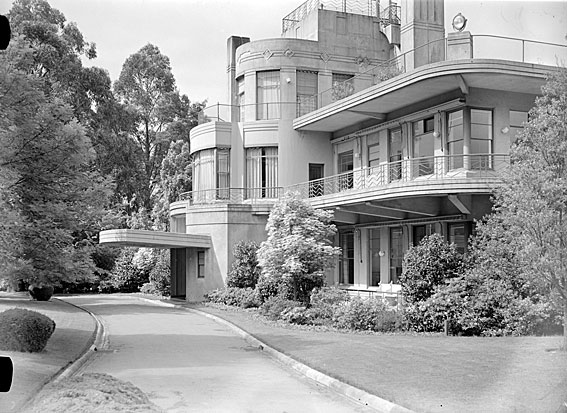
'Burnham Beeches', Olinda
[photograph by Victorian Railways / State Library of Victoria (1947)]
In 1938, it was moved to the art deco mansion 'Burnham Beeches' at Olinda, in the Dandenong Ranges, by Geo. Fincham & Sons Pty Ltd. In 1951 it was installed at Deepdene and a new console was supplied by Hill, Norman & Beard (Australia) Pty Ltd in 1965. The organ was sold (minus the console) to Rick Alabaster, of Knoxfield, in 1990. At this stage the roll-playing mechanism had been previously discarded.
| GREAT Open Diapason Flute Viola da Gamba Salicional Voix Celeste Flute Trumpet Oboe Clarinet Vox Humana Swell Sub Octave to Great Swell to Great Swell Octave to Great Choir to Great Tremulant |
8 8 8 8 8 4 8 8 8 8 |
||
| SWELL Open Diapason Flute Viola da Gamba Salicional Voix Celeste Flute Trumpet Oboe Clarinet Vox Humana Swell Sub Octave Swell Unison Off Swell Octave Tremulant |
8 8 8 8 8 8 8 8 8 8 |
(all stops shared with Great) |
|
| CHOIR (enclosed) Flute Echo Viole Viole Celeste Vox Humana Swell Sub Octave to Choir Swell to Choir Swell Octave to Choir Tremulant |
8 8 8 8 |
[1928 Echo Organ] |
|
| PEDAL Subbass Bourdon Flute Quint Octave Flute Great to Pedal Swell to Pedal Swell Octave to Pedal Choir to Pedal |
16 16 8 5-1/3 4 |
A A A A |
Compass: 61/30 (manual windchests with 73 note compass for use with octave couplers)
Chimes
Detached stopkey console4
The remaining components of the Aeolian organ were sold to Rick Alabaster in 1990.
PRESENT ORGAN
This was built in 1868 by George Fincham for the Blind Institute in St Kilda Road, Prahran, initially consisting of a single manual and eight speaking stops.
In the boys' school-room an organ has been erected, at a cost of £200. Mr. Fincham, of Richmond, is the builder, and it is doubtful if he has ever turned out a finer instrument. It is not yet completed, but when the "swell" is added, and it is moved to a better room, it will form a monument of colonial skill.5
The assemblage then proceeded to the boys' school-room where Mr Pringle performed on the organ which was made by Mr Fincham, of Richmond, at a cost of £200. It is a very fine instrument and reflects great credit upon the builder.6
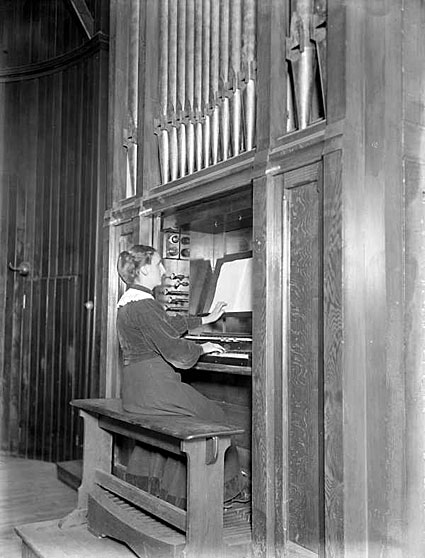
The organ at the Francis Ormond Memorial Music Hall, Institute for the Blind, being played by a blind student using braille
[photograph from State Library of Victoria (c.1900)]
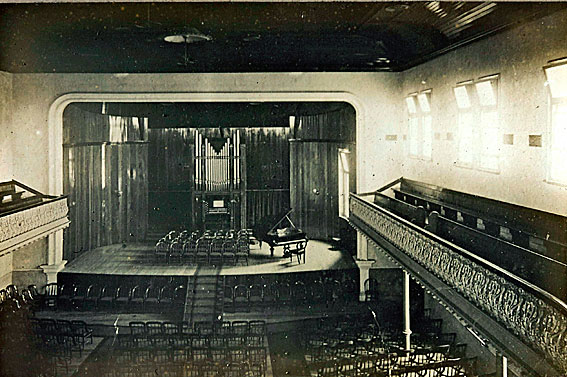
Interior of the Francis Ormond Memorial Music Hall showing the Fincham organ [A.H. Whinfield (c.1895)]
The organ was enlarged in 1891 by Fincham & Hobday with the addition of a Swell Organ of five stops and a Pedal Principal 8ft.7 It was moved to the newly completed Francis Ormond Memorial Music Hall where it was sited centrally on the stage.
In 1939, Geo. Fincham & Sons Pty dismantled the organ and re-erected it in a recess in the dining hall, including a new electric blowing plant in place of the former hydraulic mechanism. The casework was replaced, with the former Walnut casework to be converted into a book cabinet, with the addition of shelving.8
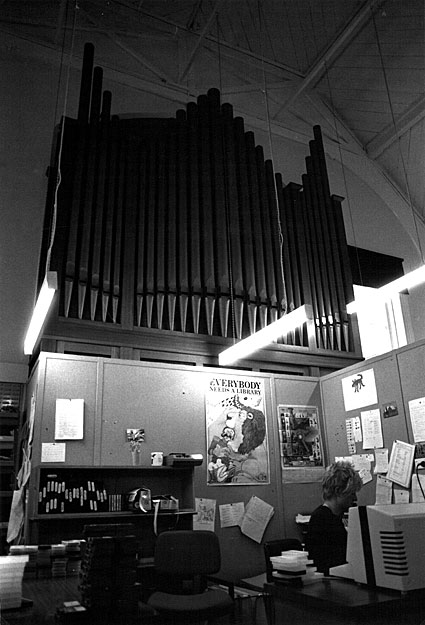
The organ as placed in the dining hall, Institute for the Blind
[photograph by W.G.S. Smith (c.1970)]
In 1953 the organ was rebuilt and enlarged to three manuals, with electro-pneumatic action and a detached stopkey console.
Musical Department.
We are proud to be able to report the completion of the reconstruction of our pipe organ. This was, from a musical aspect at least, undoubtedly the outstanding event of the year. The instrument has a most interesting history. It was originally purchased in 1868 at a cost of 200 and then had a single manual only. In 1891, a second manual was added, together with additional pipework, and in this form the organ was re-opened by the brilliant blind organist, the late Mr. H.V.E. Pascoe. In 1938 the hydraulic engine was replaced with an electric blowing plant, and in 1953 the instrument was completely dismantled, enlarged by a third manual and further pipe work, and re-built on the most modern lines with electric pneumatic action and extended console and now stands in accordance with the latest standards drawn up by the Royal College of Organists. Great care was undertaken to ensure that the original voicing of Mr. George Fincham was preserved. Through the courtesy of the Australian Broadcasting Commission, the brilliant blind French organist, M. Andre Marchal, who was visiting Australia and giving recitals, graciously consented to officially open the re-constructed pipe organ. The function was attended by a most representative gathering of organists, both blind and sighted, in Melbourne, and all concerned expressed their appreciation, not only of the recital by M. Marchal, but also of the beauty of the organ, which is now valued at several thousands of pounds.9
| GREAT Open Diapason Claribel Dulciana Principal Flute Twelfth Fifteenth Swell to Great Sub Swell to Great Swell to Great Super Choir to Great Sub Choir to Great Choir to Great Super |
8 8 8 4 4 2-2/3 2 |
||
| SWELL Geigen Principal Gedact Gamba Voix Celeste Octave Closed Horn Sub Octave Super Octave Tremulant |
8 8 8 8 4 8 |
(1891) TC 1953 |
|
| CHOIR Stopped Diapason Salicional Clear Flute Piccolo Clarinet Sub Octave Super Octave Tremulant Swell to Choir Sub Swell to Choir Swell to Choir Super |
8 8 4 2 8 |
(enclosed – 1953) |
|
| PEDAL Bourdon Echo Bourdon Principal Bass Flute Great to Pedal Swell to Pedal Choir to Pedal |
16 16 8 8 |
A A A |
Compass: 61/30
Detached stopkey console
Electro-pneumatic action10
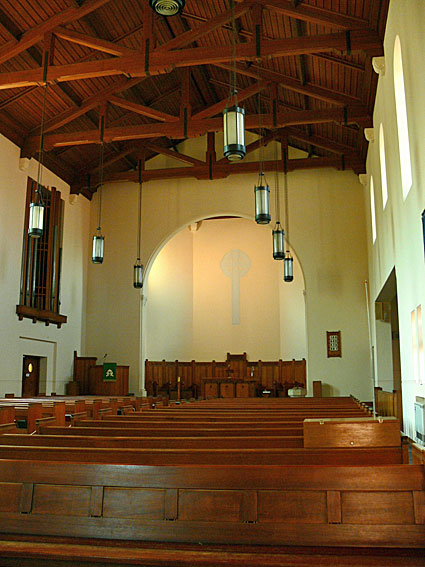
Frank Paton Memorial Uniting Church, Deepdene: interior from rear showing organ to the left
[photograph by John Maidment (c.2010)]
The organ was removed from the Royal Victorian Institute for the Blind and rebuilt in 1990 for its present location by the South Island Organ Company Ltd, of Timaru, New Zealand, its first Australian contract. It was placed in the organ chamber occupied by the Aeolian organ and utilised the screen that had been previously used. The console was detached and placed centrally in the choir recess on the opposite side of the church.
| GREAT Open Diapason Claribel Flute Dulciana Principal Flute Twelfth Fifteenth Tierce Mixture 19.22 Trumpet Swell Sub Octave to Great Swell to Great Swell Octave to Great Choir to Great |
8 8 8 4 4 2-2/3 2 1-3/5 II 8 |
1868 1868 1868 1868 1868 1868 1868 1990 1990 1926/1990 (HN&B) |
A |
| SWELL Geigen Principal Lieblich Gedackt Echo Gamba Voix Celeste Octave Mixture 19.22 Cornopean Oboe Swell Sub Octave Swell Octave Tremulant |
8 8 8 8 4 II 8 8 |
1891 1891 1891 grooved bass 1953 TC 1891 1990 1891 1907/1990 (Palmer) |
|
| CHOIR (enclosed) Rohr Flute Salicional Wald Flute Piccolo Clarinet Trumpet Swell Sub Octave to Choir Swell to Choir Swell Octave to Choir Tremulant |
8 8 4 2 8 8 |
1953 1953 1953 1953 1953 1926/1990 |
A |
| PEDAL Open Diapason Bourdon Principal Bass Flute Octave Trombone Great to Pedal Swell to Pedal Swell Octave to Pedal Choir to Pedal |
16 16 8 8 4 16 |
1928/1990 (HN&B) 1868 1891 1868/1990 1891/1990 1926/2018 |
B C B C A |
Compass: 61/3011
The recycled pipework came from the Civic Theatre, Christchurch, St Mary's Church, Merivale and Christ's College, Christchurch.12
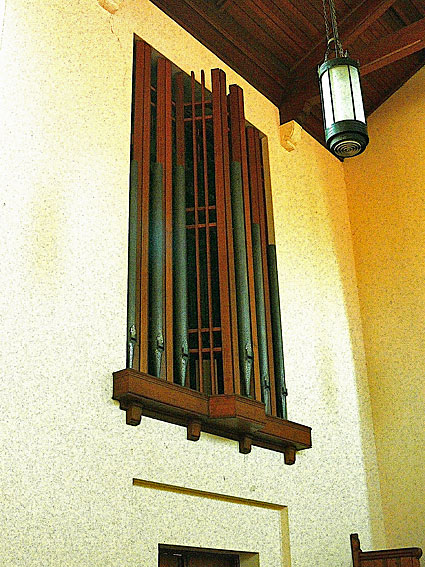
Frank Paton Memorial Uniting Church, Deepdene: organ facade
[photograph by John Maidment (c.2010)]
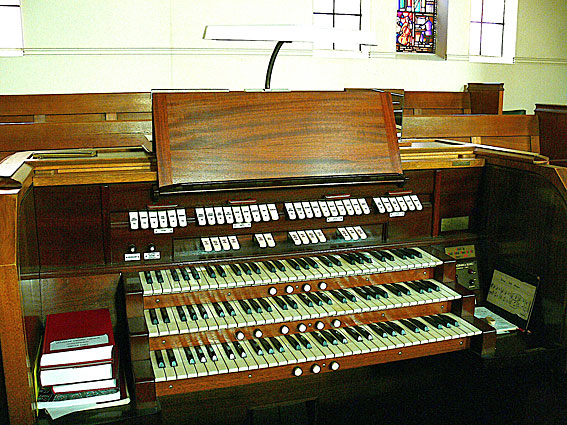
Frank Paton Memorial Uniting Church, Deepdene: refurbished HN&B console
[photograph by John Maidment (c.2010)]
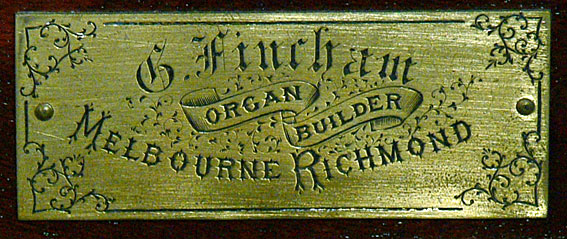
Frank Paton Memorial Uniting Church, Deepdene: Fincham nameplate from 1868
[photograph by John Maidment (c.2010)]
1. The Argus, 6 March 1941, p.8
2. The Argus, 25 November 1941, p.4
3. Rollin Smith, The Aeolian Pipe Organ and its Music. 2nd ed. Villanova, Penn.: OHS Press, 2018, p.409.
4. Specification noted 1967 John Maidment
5. The Argus, 21 August 1868, p.5
6. The Age, 22 August 1868, p.3
7. E.N. Matthews, Colonial Organs and Organbuilders. Carlton: Melbourne University Press, 1969, p.144
8. Fincham letter 6 March 1939.
9. Portland Guardian, 5 October 1953, p.3 citing the Royal Victorian Institute for the Blind Annual Report of Activities
10. Specification noted 1966 John Maidment
11. William Martin & Eric Stokes, "The Organs in the Frank Paton Memorial Church, Deepdene", Victorian Organ Journal, October 1990, pp.19-23, 37
12. Jill Worrall, More than a Pipe Dream (Nelson South, NZ: Renaissance Publishing, 2019), p.86